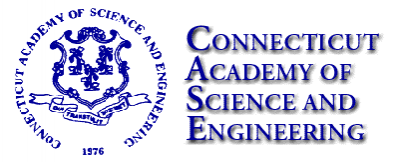Research Sponsors
Current Projects
Nanostructured Armature Winding Insulation for Electric Propulsion Motor with High Torque Density


This research focuses on increasing the torque density and payload efficiency of large electric propulsion machines by using a new nanostructured armature winding insulation material. In this research, we are collaborating with a group from the Institute of Materials Science, UConn. Our group's focus is on multi-physics FEA simulation of a large electric machine using different insulation materials. The simulation analyses will provide estimation of the enhancement of the machine's torque density and efficiency as well as instruct the machine re-rating process. A high-voltage and high-frequency system is designed to perform the aging study of nano-structured materials which will be used in specific medium- and high-voltage applications. The power stage is designed with commercial high-voltage high-power switching devices, control circuitry is designed to control the power supply and the high-power switching devices. The time to failure and the dv/dt properties of material under test are of special interest.
Resilient Extra Terrestrial Habitats - Smart Power Distribution System
This research aims at developing models for sources, loads, and energy management in resilient extraterrestrial habitats. The models are integrated into a more elaborate system of systems Simulink model, and focus on fault propagation as well as internal and external disturbances. A cyber-physical testbed is planned as part of this project to demonstrate FDD and operational scenarios.
Self-Healing Multi-level Power Converters

A modular approach to ac/dc, dc/dc, and dc/ac conversion is followed such that the single module has self-healing capabilities. Self-healing is characterized by the ability of the converter to diagnose or predict internal faults, and respond by reconfiguring itself to maintain operation within certain constraints.
Hierarchical Control of Multi-Drive Systems
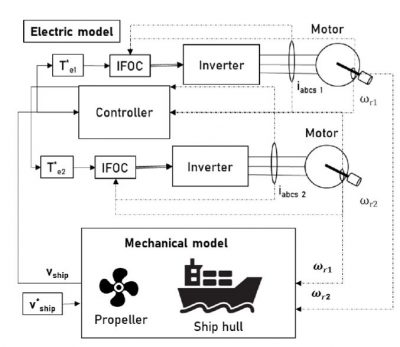
This project aims at establishing redundancy and operating it in optimal manner for maximum efficiency, maximum availability, or other objectives when multiple drives are used. Focus is on switched controller theory and design, redundancy management in multi-level power converters, and machine-inverter interaction and maximum efficiency control.
A method for generating an optimally attractive scent for Asian Citrus Psyllid (ACP) biocontrol

Citrus orchards in parts of the U.S. have been suffering from ACP and require biocontrol. Automation is critical in this process, in order to disperse optimal scents that attract and kill ACP. This project aims at characterizing graphene as a medium for controlling scent release, and automation design including power supply design for multi-channel independent control outputs.
Additive Manufacturing of Electric Machines for Underwater Vehicle Applications
This exploratory research focuses on characterization of various ferromagnetic material used in 3D printing with comparison to other material manufactured for electric machine usage using standard manufacturing methods. Focus is on power loss characterization, and optimal 3D design spaces that are not usually explored with laminations and 2D projections.
Optimal Light Duty EV Charging Station Locations with Supplemental Clean Energy Microgrids
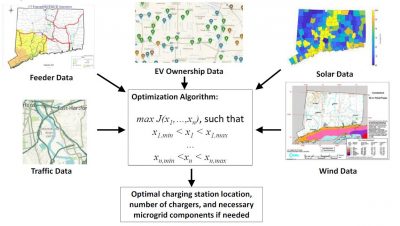
The project aims at using various data available in Connecticut to determine optimal locations of EV charging stations, and the number of chargers per station. Focus is given to availability of feeder capacity, as well as a microgrid design tool for areas where EV chargers are necessary but utility feeder capacity is limited.
Selected Previous Projects
Adaptive Modulation Time-Domain Fault Diagnosis of Three-Phase Induction Machines

AC induction motors are the workhorses are the industrial world, and as such, faults in the motor must be detected quickly and effectively so that the motor can be repaired before further damage is done. The focus of this research is to develop a simple time-domain method of identifying all four major induction motor fault types (eccentricity fault, broken rotor bar fault, bearing fault, and stator short winding fault) at an early stage, with an implementation that will require minimal signal processing and no additional sensors besides those already in place for control purposes. This novel method has the ability to adapt to the speed and torque conditions of the motor and is called adaptive modulation.
Machine Learning Approaches for Si and SiC IGBT and MOSFET Failure Diagnosis and Prognosis

This project aims at establishing a computationally-efficient platform to perform fault prognosis and diagnosis in DC/AC inverters which use Si or SiC MOSFETs or IGBTs. We collaborate with another UConn group on the machine learning algorithms, and optimize the implementation on standard FPGAs and DSPs for hardware-in-the-loop verification and testing. We also tie physical degradation and failure aspects to data trends.
GaN Capacitive Wireless Charging
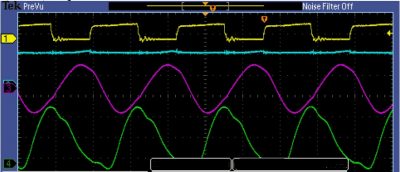
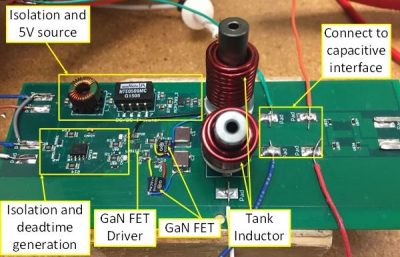
This research investigates the efficiency and cost of the H-bridge and half-bridge converters as transmitter drivers in a capacitively-coupled wireless energy transmission system for tablet applications. The H-bridge and the half bridge were chosen due to their popularity, widespread implementation in resonant power converters, simplicity, and low cost. The system was designed at the component level using theoretical calculations and a simplified model of the system was then simulated in MATLAB/Simulink. After validation of the designs, both systems were constructed and their efficiency and cost were analyzed. The results indicate that H-bridge is more efficient and the half-bridge is more cost effective in capacitively-coupled charging applications. GaN is an enabling technology to improve the energy transmission and switching frequency.
Modeling and Optimization of Reconfigurable Multilevel Inverter to Improve Power Quality
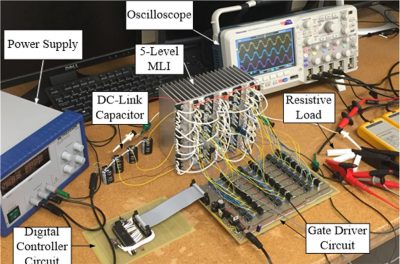
This research proposes an analytical model of SPWM harmonics which can include both high and low harmonics. The SPWM model is derived on the level-shifted PWM case for a neural point clamped (NPC) inverter as an example. Then the proposed model is utilized to study the impact of different reconfiguration methods on the line-to-neutral voltage and explore the harmonic contents and effects to emphasize that voltage quality improvement should go beyond just maintaining the desired line-to-line voltage shape. Besides mathematical model based analysis, simulation in MTLAB/Simulink is performed to verify the proposed model and a 5 level Neutral Point Clamped (NPC) inverter is built in hardware to perform more analysis of RMS and THD. Finally, optimization of reconfiguration methods is proposed to improve the existing reconfiguration methods.
Logic-Based Methods for Intelligent Fault Diagnosis and Recovery in Power Electronics
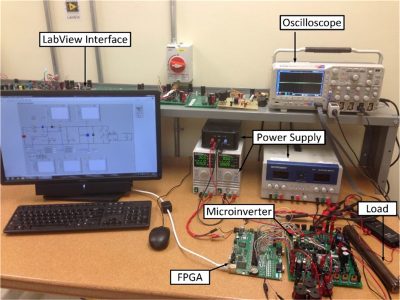
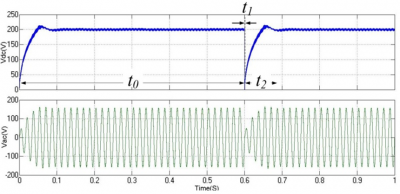
This research proposes logic-base methods using combinational and fuzzy logic to diagnose faults in power electronic systems. This method can extend to faults in the source, load, and other parts of a power electronic system besides power electronic components. The methods presented in this research are characterized by simplicity for implementation on existing digital platforms, and accuracy in detecting several faults that may occur in a variety of components. Redundancy strategy is utilized to recover the failed system by replacing the failed component. Redundancy of power components may not be cost-effective for a single micro-inverter, however, it is cost-effective when a single fault may cause the complete replacement of the micro-inverter.
Modeling Efficiency, Cost, and Reliability of Power Electronics
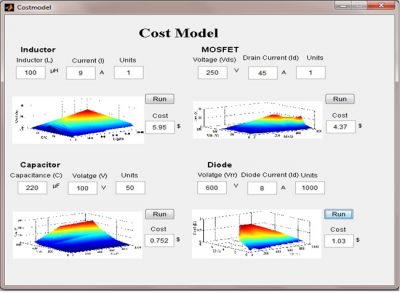

With power electronics converter design being a multi-variable optimization problem (efficiency, performance, cost, and reliability) these essential characteristics have to be evaluated and improved. This research aims at developing models of these different characteristics with the current focus being on efficiency and cost. The tools developed currently address basic DC/DC converter tolopologies can be extended to many others. The tools are capable of estimating power losses in these converters and approximate costs (based on surface-fit models) with specific component parameters, and can also run in "optimization" mode where part numbers are suggested from a large database for minimum loss or minimum cost. Efficiency of the whole converter is estimated from the power loss of different components aggregated into different topologies. The converter cost is also estimated based on available component options. The tools only take datasheet and converter ratings for the component-specific mode, and only converter ratings for the optimization mode.
Combining Electric Drive Energy-Efficiency and High Performance for HVAC Applications
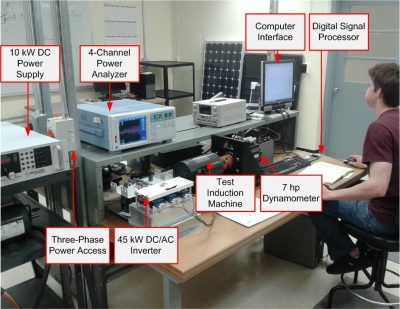
This research was sponsored by United Technologies Corporation (UTC-BIS). This research focuses on combining efficiency enhancement algorithms and methods in electric drives by minimizing losses in power electronic inverters and electric machines using real-time optimization, while focusing on maintained high performance control of these drives. Embedded systems holding this algorithms and their interaction with their surrounding power electronics and electric machine is of main interest. This research is supported by United Technologies Corporation (UTC-BIS)
Solar Photovoltaic DC and AC Conversion

Micro-inverters have seen significant interest in both academic research and industrial venues. Their existance in grid-tied solar photovoltaic systems is desired for different efficiency and reliability reasons. But, some applications such as battery-charging, stand-alone micro-grids, and even residential installations might just a regulated dc output. This project investigates existing and new dc/dc and dc/ac topologies for solar photovoltaic applications with focus on their applicability.
Integrated Solar PV and Thermoelectric Energy System
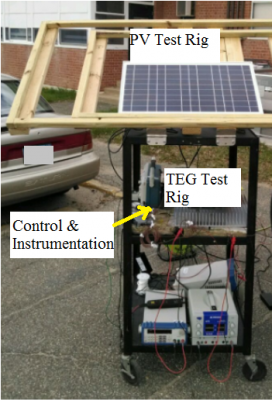
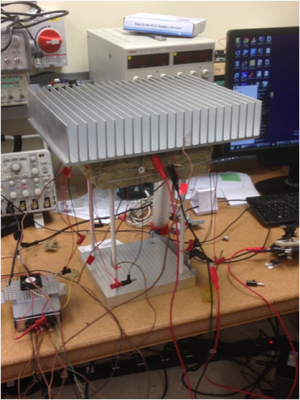
This research addresses the combination of PV and thermoelectrics into a single hybrid energy system. The test rig shown below currently combines these sources with maximum power extraction from each to charge a battery, and further research on optimal performance and energy harvesting is being investigated.
Modular Linear Induction Machine

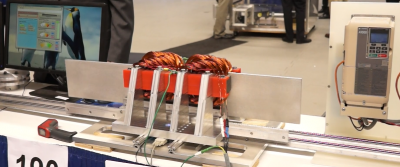

A senior design team (Jonathan Rarey, Julio Yela, and David Hackeny) successfully simulated, designed, built, and cotrolled a linear induction machine that is highly modular for further research on construction, material, control, and various other topics. The team won first place in the ECE senior design competition during Fall 2013-Spring 2014.
Modeling and Real-Time Simulations of Microgrids with Significant Renewable Penetration
This research has already established or upgraded existing dynamic models of major microgrid components in line with UCONN's recently awarded microgrid on Depot Campus. These dynamic models are being utilized to evaluate the microgrid's response under uncertain operating conditions, in addition to the performance of power electronic controllers to microgrid faults, islanding, and grid connection.
Real-Time Emulation and Simulation of Electric Vehicles and Electric Ship Propulsion

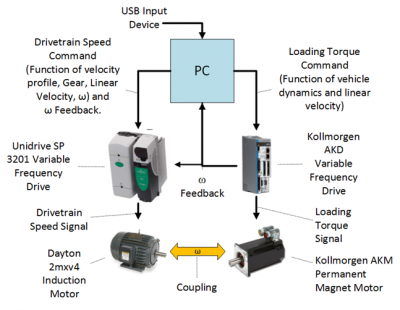
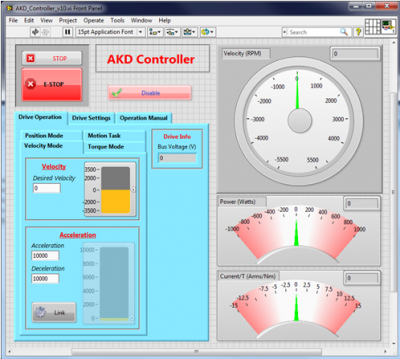
Real-time simulation is a major time-saving tool for lengthly simulations. This research focuses on utilizing realt-time simulations of an electric vehicle and a ship propulsion system to evaluate their efficiency, performance, and reliability. In parallel with the sumulation, a real-time vehicle emulator has been implemented in LabVIEW by taking into consideration major vehicle dynamics and real driving schedules. Various other research topics in terms of vehicle safety are being investigated with results that will be soon reported in publications.














